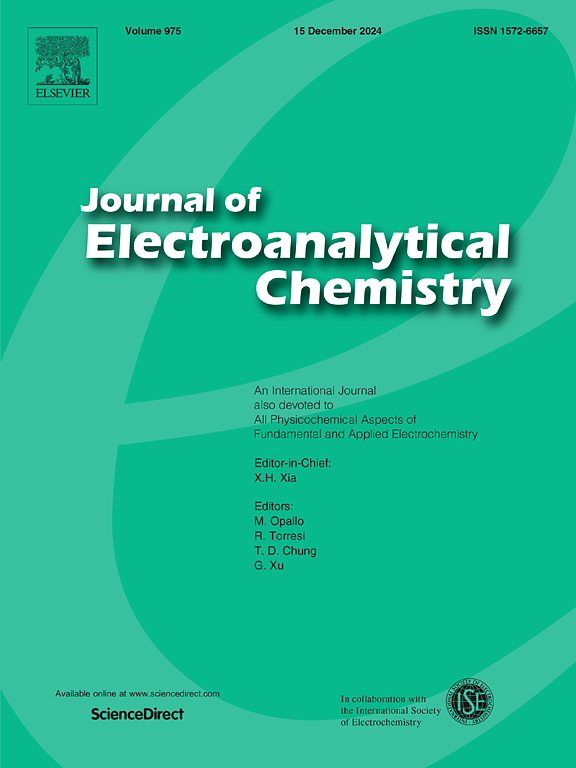Nanoflower-like Fe-doped CoP as highly efficient catalyst for alkaline hydrogen evolution reaction
IF 4.1
3区 化学
Q1 CHEMISTRY, ANALYTICAL
引用次数: 0
Abstract
Transition metal phosphides (TMPs) have drawn much interest as a promising electrocatalyst with outstanding physicochemical properties. However, limited active sites and sluggish kinetics greatly limit their widespread applications. Herein, a highly efficient nanoflower-like TMPs of Fe-doped CoP catalyst is tactfully prepared. Electrochemical experiments indicate that the Fe-doped CoP catalyst with 30 min exchange duration time (FeCoP/NF-30) exhibits an extremely low overpotential of only 66.60 mV to achieve a current density of 10 mA cm−2, a Tafel slope as low as 48.34 mV dec−1 and a large electrochemical active area of 32.32 mF cm−2 in alkaline solution. The enhanced hydrogen-evolution performance of FeCoP/NF-30 is attributed to the increased active sites and decreased crystalline feature, which is beneficial to adsorbing or desorbing reaction intermediates. In addition, an increased electron density around Co element is observed, which also can promote HER performance. This work not only provides a facile strategy for developing efficient CoP electrocatalysts but also promotes fundamental studies on catalyst design for electrocatalysis and beyond.

纳米花状掺铁 CoP 作为碱性氢气进化反应的高效催化剂
过渡金属磷化物(TMPs)作为一种具有优异理化性能的电催化剂,受到了广泛的关注。然而,有限的活性位点和缓慢的动力学极大地限制了它们的广泛应用。本文巧妙地制备了一种高效的fe掺杂CoP催化剂的纳米花状TMPs。电化学实验表明,交换时间为30 min的fe掺杂CoP催化剂(FeCoP/NF-30)在碱性溶液中的过电位仅为66.60 mV,电流密度为10 mA cm−2,Tafel斜率低至48.34 mV dec−1,电化学活性面积达32.32 mF cm−2。FeCoP/NF-30的析氢性能增强是由于活性位点的增加和晶体特征的减少,有利于反应中间体的吸附或解吸。此外,Co元素周围的电子密度增加,也有助于提高HER性能。这项工作不仅为开发高效的CoP电催化剂提供了简单的策略,而且还促进了电催化及其他领域催化剂设计的基础研究。
本文章由计算机程序翻译,如有差异,请以英文原文为准。
求助全文
约1分钟内获得全文
求助全文
来源期刊
CiteScore
7.80
自引率
6.70%
发文量
912
审稿时长
2.4 months
期刊介绍:
The Journal of Electroanalytical Chemistry is the foremost international journal devoted to the interdisciplinary subject of electrochemistry in all its aspects, theoretical as well as applied.
Electrochemistry is a wide ranging area that is in a state of continuous evolution. Rather than compiling a long list of topics covered by the Journal, the editors would like to draw particular attention to the key issues of novelty, topicality and quality. Papers should present new and interesting electrochemical science in a way that is accessible to the reader. The presentation and discussion should be at a level that is consistent with the international status of the Journal. Reports describing the application of well-established techniques to problems that are essentially technical will not be accepted. Similarly, papers that report observations but fail to provide adequate interpretation will be rejected by the Editors. Papers dealing with technical electrochemistry should be submitted to other specialist journals unless the authors can show that their work provides substantially new insights into electrochemical processes.

 求助内容:
求助内容: 应助结果提醒方式:
应助结果提醒方式:


